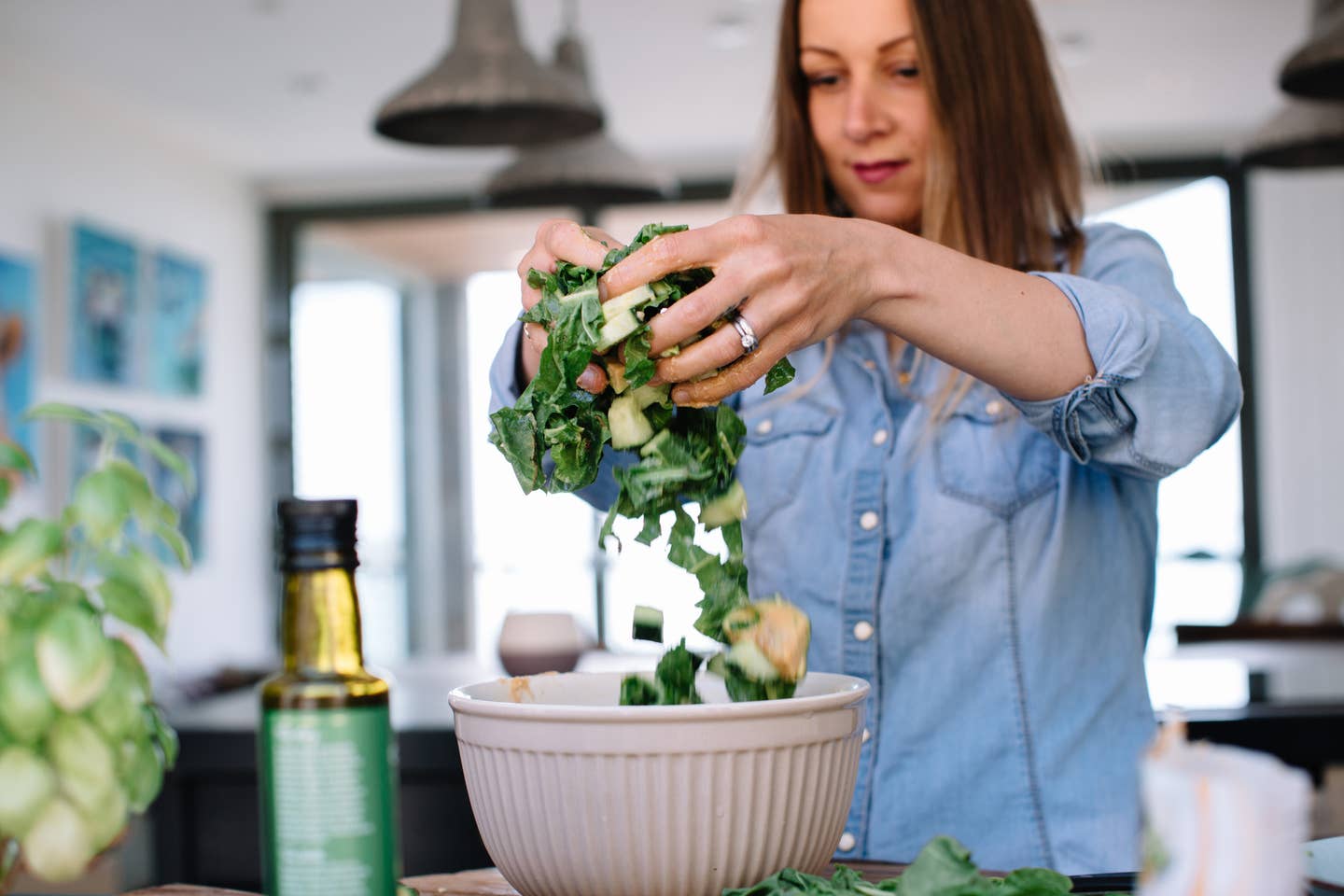
Here’s The Secret to Going Keto and Losing Weight on a Plant-Based Diet
Everyone asks, can I be keto and vegan and lose weight while still eating plant-based? After all, vegetables are mostly complex carbs, and on a keto diet, carbs are the enemy. The less of them you eat the better. We went to two trusted sources to get the scoop on how you can achieve this perfect balance: Spark your body into burning fat and still eat plant-based, and lose weight. The easiest way to start putting your body in fat-burning mode is to combine eating keto and vegan with Intermittent Fasting, which allows the body to burn fat sooner, and become what's called "fat adaptive," meaning burn fat stores for fuel.
There are three ways to jump-start ketosis on a plant-based approach
"I would call the keto diet a body hack for weight loss," says Suzannah Gerber, who has been plant-based for most of her life, is a top chef and author of Plant-Based Gourmet. "It's not centered around health. It's centered on weight loss," Gerber adds. She is something of a keto expert since she has developed keto recipes and plans, and she has successfully done keto plant-based diets numerous times herself. She tells people to only go keto for a short time, no more than two months, for health reasons, since it can be less healthy for anyone with heart disease in their family, due to the high-fat content of the diet.
She explains that keto is possible on a plant-based plan, but it can take a little longer to achieve that fat-adaptive state (like a week or two) due to the high carb content of vegetables. One secret to jump-start the ketosis process (where ketones in your body indicate the body is using fat for fuel) is to add in Intermittent Fasting, where you eat little or nothing for a window of approximately16 hours, causing the body to burn fat, and then you eat keto for the remaining 8 hours. The other way to spark fat burning is to exercise intensely, such as interval training, to force the body to turn to dip into stored calories once the available blood sugar and stored glycogen in your muscles get used up.
The third way to burn fat faster is simply to lower your overall calorie intake and load your plate with as many fresh vegetables as you can, and look for the ones that are highest in fiber since digesting high-fiber foods lowers the overall carb load of your food, known as "net carbs" in the keto world. The higher the fiber, the less your body can use the carbs since it's working hard to digest and fiber keeps insulin in check. You end up burning calories and not storing them, so fiber is like the keto diet's helper. More fiber means more fat burning.
The secret to going keto and losing weight on a healthy plant-based diet
"You are prioritizing plant-based fats from nuts, plant-oils, and whole foods like avocados. It may take a few days of eating this way to get into ketosis, explains Gerber, since there is a "fat adaptive" period in all keto diets, where you train the body to burn fat for fuel, but you can speed this up by practicing intermittent fasting, which is not eating for up to 14 or 16 hours and then eating keto-friendly plant-based foods during the 8 to 10 on-hours, focusing on eating a plant-based diet. She suggests that you have to leave off bread, alcohol and other carbs that will put you over the limit of 5 percent of your calories a day from carbs. Dr. Jason Fung, author of Life in the Fasting Lane, told The Beet that his patients often combine Intermittent Fasting and keto diet choices for the fastest weight loss results.
The foods to eat for keto plant-based weight loss: Net carbs of 5 grams or lower
Practically speaking, Gerber explains, you have to add as many vegetables as possible to your plate to lose weight. "There are some vegetables that are high in carbs and some not so high and it's about understanding the fiber content." She explains that broccoli rabe is high in fiber and low in carbs, while broccoli is the other way around. So while it seems random, there is a list of foods that are both keto and plant-based. These are the ones you eat on repeat, she told us. Once you get the hang of it, Gerber adds, it's easy to fill up on fiber and not feel hungry.
"I found it nearly impossible to get to the number of calories in a day that I needed," Gerber explained "and that is not usually my problem!"
One of the obstacles is that it can take 2 weeks on a vegan keto diet to become fat adaptive, she added. So be patient, or add in exercise, or try combining keto and plant-based with intermittent fasting, she recommends. And know this: "Avocado is your new best friend."
Here is the hero list of plant-based keto foods that she recommends:
- Nuts: Pecans and walnuts are quite low in carbs. Macadamia nuts might be the best. You learn where the different choices are and focus on those.
- Greens: Spinach and broccoli rabe are low in net carbs. And so is green pepper. Choose green instead of yellow or orange or red peppers for the net carbs.
- Meatless meat and non-dairy cheese replacements. If you need to get a fair amount of oils this is a way to go. It's much easier to get oil from meatless meat and non-dairy cheese than just in vegetables alone.
- Cashew butter in a smoothie, or almond butter. Keep your protein and nut fats high.
- Avocado are your best friend. You'll want to have avocado on everything, with every meal.
For keto-friendly foods look for vegetables with the lowest net carbs such as:
"Tell yourself that you have a two-month plan on the keto approach, and then you go into a new two-month plan that is more protein-focused, and more balanced between the protein and the fat," Gerber recommends. "Then use that time to exercise and eat to support building up muscle tissue, which is also going to play a positive metabolic roll and reduce cardiovascular risk."
If you approach the keto plant-based diet as a finite "micro" diet phase, and you know it's restrictive, Gerber explains, you can lose 10 percent of your body weight and most of it adipose tissue -- meaning body fat-- and stay plant-based. When you get to the end of six months or a year after doing this and you will likely not have put the weight back on and you'll still have better muscle tone and a new baseline.
By the end of the six months of cycling through keto and plant-based, then maintaining your healthy approach, you will be eating a more diverse array of foods, "with some sanity," she adds. So when you go keto on a plant-based diet, only try it in short bursts. It's still effective, but this way it's also healthy.
Keto is strict, but it helps you break bad habits and lose weight fast, which is rewarding
"These kinds of heavily restrictive diets can serve a role to break your bad habits." Gerber points out. "You've gotten into this habit and now you are going to break yourself of this habit. Because you are adhering to a new way of eating and you can understand better what you are eating from a different point of view."
The South Beach Diet, Atkins, Sears and other precursors to today's keto diet plans, all allowed as much broccoli and salad greens as you wanted, she points out, since they filled you up. But on a keto diet, it's much, much, much, stricter, and eliminates many more foods. "Beans are high carbs on a keto diet. Yes, they do have high fiber but you still end up too high for the day. If the goal is 125 net carbs a day, like on South Beach, then beans and broccoli are nothing. But if your goal is to eat 25 net carbs in a day, such as on keto, then that bowl of beans is the whole allowance.
Cycling off keto is important since you can do it in a way that you keep the weight off
Once you become fat adaptive you can raise this strict level up to 50 net carbs a day and stay within your weight goal, Gerber has found. "I had times I was doing 50 grams to 60 grams of net carbs a day once I was fully fat adaptive and I stayed at my new baseline. I teach people to spent that first week being strict because it makes up your mind you're going to do it and with intermittent fasting, on a schedule of 16/8 [16 hours not eating and 8 eating], then you are priming your body for ketosis anyway. It helps if you exercise.
Gerber said plant-based keto is so much easier since you stay energized. "I never had 'keto flu' where you feel awful and tired all day. I never had the weird body odors and felt sick the way some people report having. I hacked the system. Lots of water helps. Keeping really hydrated helps a lot. Keep in yourself calorie-restricted and Intermittent Fasting really works.
For exactly how to achieve safe, healthy weight loss by going keto on a plant-based diet, we turned to Pam Nisevich Bede, MS, RD, a registered dietician with Abbott's ZonePerfect Keto brand.
Here is her advice for anyone who wants to lose weight on a keto plant-based diet:
Q. What does it entail to be both keto and plant-based?
Nisevich Bede: A keto diet is a nutrition program that emphasizes foods high in healthy fats and low in carbs, with keto-dieters often turning to higher fat oils, butter and dairy. However, with easy swaps and substitutions, it is absolutely possible to follow both a keto and plant-based lifestyle. You can reach ketosis while following a plant-based diet by relying on high-fat, plant-based foods like coconut products, olive oil, avocados, seeds, and nuts. There are also vegan protein sources to turn to like full-fat tofu and tempeh.
Q. How do you think about your macros for the day when you're plant-based?
Nisevich Bede: Whether you follow a plant-based, flexitarian, or meat-based approach, keto macros don’t really waiver. You’ll want to aim for macros of approximately 75 percent fat, 20 percent protein, and 5 percent carbohydrates. Keep your net carbohydrate grams in mind, given that plant sources bring in more carbohydrates but also more fiber (and other vitamins and minerals). Fibers are a keto-dieter’s friend as they help to maintain healthy digestion while also aiding in steady energy levels and don’t impact ketone levels in a negative manner.
Q. What exactly should your daily intake look like on a vegan keto diet?
Nisevich Bede: For example, if you’re aiming for a calorie goal of 1,800 calories a day, your macros should look be approximately 25 grams of carbs (think handfuls of deeply colored, fiber-rich veggies), 90 grams of protein (grab tofu, nuts, and keto shakes to hit this number) and 150 grams of fat (hello, avocados and nuts!) per day on the keto diet. If you need a handy macro calculator, check out this one.
Q. When you eat plant-based you cut dairy and meat, so where do you get your fats?
Nisevich Bede: The go-to keto fat sources, like avocados, olive oil, MCT oil, and nuts, are a great place to start. However, if you’re looking to change it up a bit, add full-fat coconut yogurt to your morning breakfast routine, or spread any type of natural (no sugar added) nut butter (peanut, almond, cashew, sunflower) on to celery if you’re in need of a quick snack. Another favorite is to mix in MCT oil and grass-fed butter/coconut oil into morning coffee.
Q. How do you keep your carbs down when most plants have carbs?
Nisevich Bede: While a lot of plants are high in carbs, remember that the fiber helps with digestion and blunts an impact to the ketosis you’ve been working hard to achieve. There are plenty of non-starch options that won’t take your carb count through the roof. Reach for options like leafy greens, Brussels sprouts, broccoli, zucchini, cauliflower, peppers or mushrooms. Also, if you’re craving something sweet, blueberries, blackberries, raspberries, and strawberries can be enjoyed in moderation. To keep your fat levels up, toss with avocado oil, spread vegan butter or sprinkle cashew cheese on your favorite non-starchy vegetables at dinnertime.
We tried the keto vegan diet (or is it the vegan keto diet?) to see if we could do it.
Check out this video and read what happened when The Beet's editor Hailey Welch and contributing video creator Caitee Anderson tried the keto vegan diet to see if it could be done. This is the same duo that tried out Adele's Sirtfood Diet and nearly fainted from the experience (It only allows 1,000 calories a day, but hey, there's red wine and chocolate.)
More From The Beet






